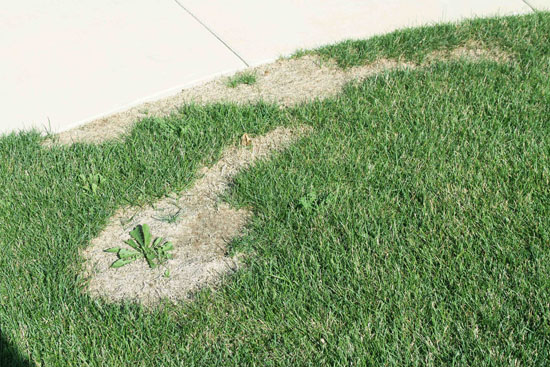Issue 14, September 8, 2014
Mistakes People Make in Weed Control
I read once on a bumper sticker that "Mistaeks Happen". It's true. We're all human. Fortunately, we learn from our mistakes, most of the time. As Groucho Marx put it so well, "Learn from the mistakes of others. You can never live long enough to make them all yourself."
Often mistakes happen in weed control. Many are preventable simply by carefully reading, understanding, and following the herbicide label. Spills can be prevented but let's face it, they still happen.
In addition to the label directions being understood, the herbicide mode of action should also be understood at least somewhat. How is it taken up by the plant? Where does it need to be put so uptake can occur? A gentleman told me recently that he had tried to use a herbicide on his tree seedlings growing around his house and his control attempts were unsuccessful. We discussed his application methods and he said that he knew trees took things up from the roots. Therefore, he applied the herbicide to the ground. Unfortunately, his herbicide should have been applied to the leaves. Had he read the label? No.
Does the herbicide move in the plant? Is it systemic? If so, patience is needed as it will take a while for injury symptoms to appear on the leaves followed by complete kill if all goes well. Once I was hired to do some garden work for a professor. She had me spray some weeds with a systemic herbicide. Upon completion of that activity, I inquired about my next task. She gave it some thought, handed me a knife, and told me to return to the weeds I had just sprayed and cut them down. We then had a little chat about how her herbicide works and that patience and time were needed.
How much herbicide is needed to kill unwanted weeds? If a little is good, isn't more better? No. That line of reasoning only works with things like chocolate. Some would argue it won't even work with that. Again, the product label will give specific guidance on rates. The maximum rate should never be exceeded. Rates have been carefully evaluated to determine what is most effective. Herbicide rates that are too high can result in poor weed control due to damaged or burned plant tissue which prevents absorption into the plant. It's like setting out to break into a house by first setting fire to the door.

Roundup probably used to kill dandelion and sidewalk edge weeds.
What about homemade mixtures? Aren't they safer and less expensive than traditionally manufactured herbicides? Recipes abound on the internet but they aren't recommended. It's best to use research based products that come with labels that provide application specifics and tell you how to properly cover up your body just in case something goes wrong and the weed killer ends up in your eye (vinegar is caustic by the way). Recently, a weed scientist in Wyoming compared a "homemade" herbicide recipe to glyphosate. He took at close look at the effectiveness, cost, and toxicity of both. There are vinegar-containing EPA registered products available in a garden center near you. Check them out! But it helps to know what type of weed you are trying to control, yet, another mistake commonly made! Vinegar burns off the top growth and won't move down into the roots. Just like the Terminator, your perennial weeds will be back!
One last mistake is allowing weeds to develop seeds or letting those seedheads remain on site. It's late in the growing season. Our landscapes likely have more weeds than we care to admit. Usually the heat makes us retreat to the cooler house. We're tired and weary and perhaps ready for frost so the last zucchini plant will finally die. We'll start fresh next year. But allowing weed seeds to stay ensures more work for the next several years. The old saying, "One year's seeding makes seven years' weeding" is sadly inaccurate when it comes to certain weeds that may remain viable for say 50 years. If hand removal of the entire weed seems too daunting, simply pull out or cut off the tops and bag them for disposal.
Finally, don't spend too much time worrying about your mistakes. Mistakes become experience. (Michelle Wiesbrook)
Author:
Michelle Wiesbrook